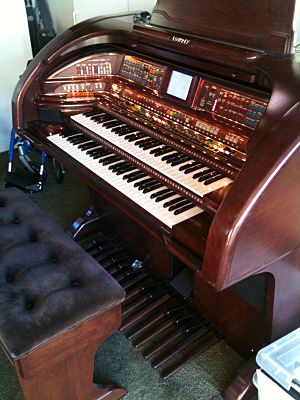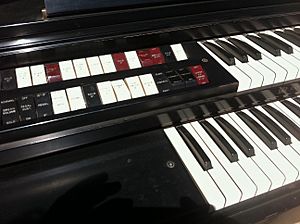Lowrey organ facts for kids
The Lowrey organ is a type of electronic organ. It was named after its creator, Frederick C. Lowrey. He was a clever businessman from Chicago.
In 1955, the first successful full-sized Lowrey organ came out. It was called the Model S Spinet, or Berkshire. Before that, Lowrey made something called the Organo. This was an attachment that turned a piano into an organ! It was first sold in 1949.
During the 1960s and 1970s, Lowrey was the biggest maker of electronic organs in the world. By 1989, the company had made one million organs! Lowrey organs were built in Illinois, USA, until 2011. After that, some models started to be made in Indonesia.
Contents
How Lowrey Organs Were Made
Frederick Lowrey spent many years, from 1918 to the 1940s, trying out different ways to design electronic organs. He wanted to find the best way to make their sounds.
In the 1940s, he decided to use something called the Eccles-Jordan circuit. This circuit used a stable flip-flop oscillator. It became a special feature of Lowrey organs.
Lowrey organs made all their sounds using electronics. This was different from their main competitor, the Hammond organ. Hammond organs used spinning metal wheels to make sounds until 1975.
Lowrey was also ahead of Hammond in adding cool automatic features. In 1968, they added automatic rhythms. In 1970, their Genie model could even play automatic left-hand parts and foot pedal sounds!
Lowrey organs were mostly made for people to play at home for fun. But Lowrey also made larger organs for churches and theaters.
Famous Musicians and Lowrey Organs
In the 1960s and 1970s, some famous rock groups used Lowrey organs in their music.
- Garth Hudson from the band The Band played a Lowrey Festival organ on many of their well-known songs. You can clearly hear its sound at the start of their 1968 song "Chest Fever".
- The Beatles used a Lowrey organ in their 1967 song "Being for the Benefit of Mr. Kite!". It helped them create a fun, fairground sound. They also used a Lowrey DSO Heritage organ for the beginning of "Lucy in the Sky with Diamonds".
- The Who used a Lowrey Organ in their song "Baba O'Riley". They used a special "marimba repeat" setting to make a sound like a synthesizer in the background.
- Mike Oldfield used the Lowrey organ a lot on his famous Tubular Bells album and other albums.
- The song State of the Art by Gotye was written to show off the sounds of the Lowrey Cotillion D-575 model.
Later Lowrey Organ Models
From 1966 to 1971, Lowrey made special organs for the guitar company Gibson. The most popular one was the Kalamazoo K-101 from 1966, which was later called the Gibson G-101.
These Gibson organs were based on Lowrey's own models. But they had extra features like "Repeat," "Glide," and "Trumpet Wow-wow" that gave them a unique sound.
In the late 1970s, Lowrey home organs had cool features like Magic Genie Chords, Track III Rhythm, and the Automatic Organ Computer.
In the 1980s, Lowrey introduced the MicroGenie series. These were smaller, portable organs with built-in speakers. Some could even run on batteries! Models included the MicroGenie V60 and the V600 Pro, which could be programmed and had MIDI capability.
Lowrey Joins Kawai
In 1988, the Lowrey company was bought by Kawai, another musical instrument maker.
However, on October 5, 2018, it was announced that Lowrey organ production would stop in January 2019.
- Lowrey Organ
Images for kids
See also
 In Spanish: Órgano Lowrey para niños
In Spanish: Órgano Lowrey para niños







